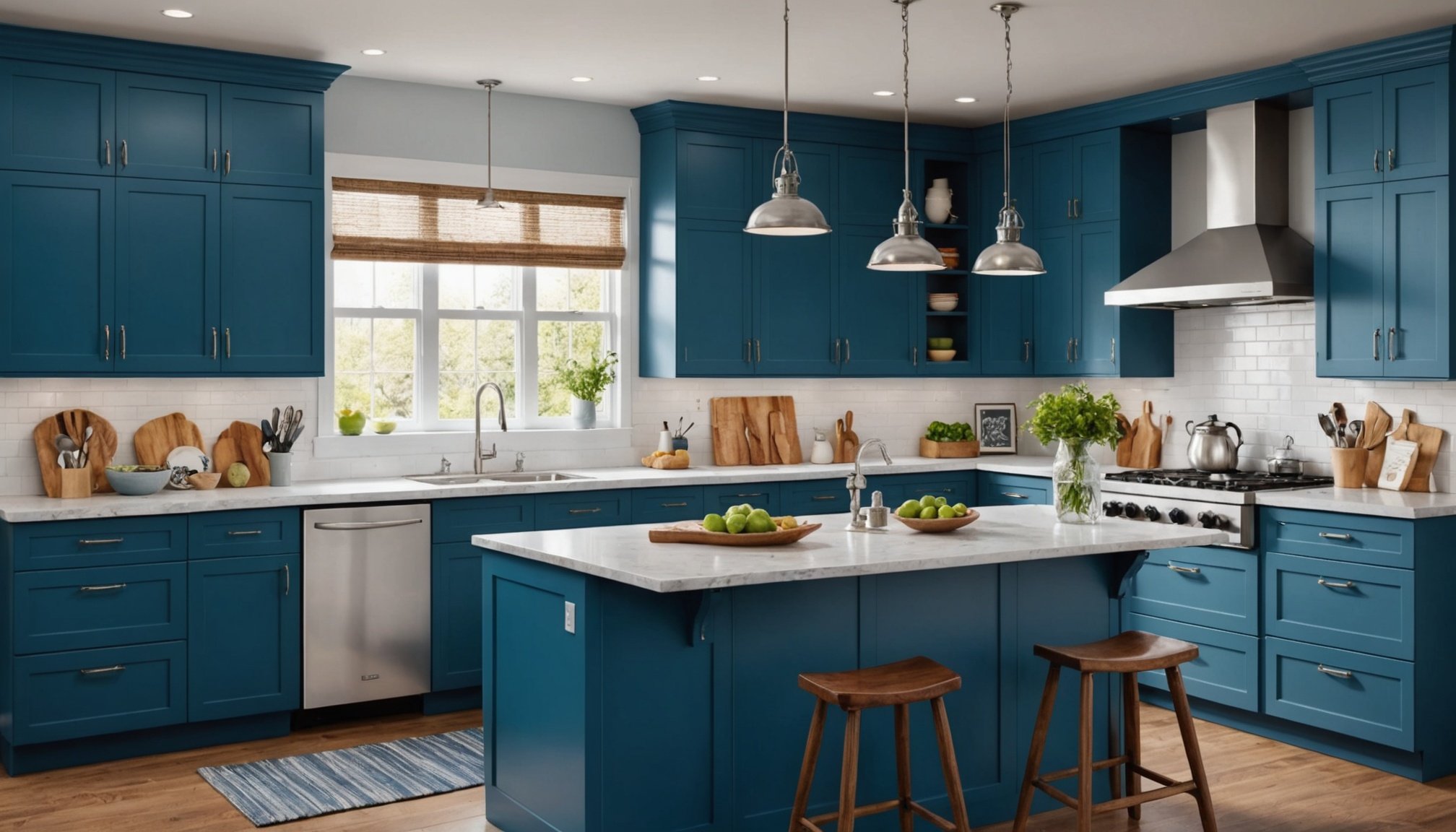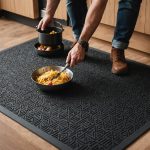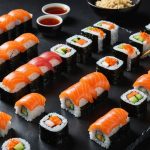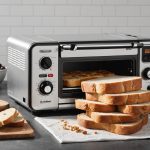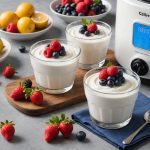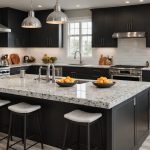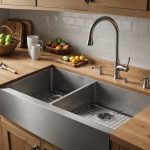Choosing the right color for your kitchen could impact not just aesthetics, but appetite control and weight loss. Blue hues, known for their calming effects, can help curb cravings and promote mindful eating. Incorporating these shades into your kitchen design creates a soothing environment that supports healthier eating habits. Explore how the perfect blue can transform your culinary space while encouraging a positive relationship with food. A simple color choice might be the key to achieving your wellness goals.
Understanding the Psychological Impact of Blue Colors
Exploring the nuances of color psychology in kitchen design.
Also to discover : Discover the Best Ergonomic Bar Stools for Active Sitting and Improved Digestion in Your Kitchen
Overview of Color Psychology
Color psychology plays a crucial role in our daily lives, subtly influencing our emotions and behaviors. This field examines how different hues impact our perceptions and actions. In kitchen design, the choice of color can affect mood and even appetite.
Blue Shades and Appetite
Interestingly, blue is often associated with appetite suppression. Unlike warmer colors, which can stimulate hunger, blue tends to have a calming effect, reducing the desire to eat. This is why you might see fewer blue restaurants or food packaging. A study found that people consumed less food when dining in a blue room compared to a red or yellow one.
Also to read : Essential Kitchen Design Features for Effortless Diabetic Meal Preparation
Research Findings
Research has shown that blue can be beneficial for weight management. Its calming properties can help individuals become more mindful of their eating habits, potentially leading to healthier choices. For those looking to control their appetite, incorporating blue elements into their kitchen design might be a practical solution.
Key Points
- Color Psychology: Understanding the impact of colors on emotions and behavior.
- Blue and Appetite: Blue can suppress appetite, aiding in weight management.
- Research: Studies suggest blue's calming effect promotes mindful eating.
By considering the psychological effects of color, particularly blue, one can create a kitchen environment that supports healthier eating habits.
Popular Blue Shades for Kitchen Design
Discover the trending hues that are transforming kitchens.
Trending Blue Shades
Incorporating shades of blue into kitchen design has become a prominent trend. Among the most popular are navy, sky blue, and teal. Each offers unique aesthetic and psychological benefits, making them ideal for different kitchen environments.
Navy
Navy is a classic choice, known for its sophistication and depth. It pairs well with metallic accents and white cabinetry, creating a timeless look. However, it can make small spaces feel more confined.
- Pros: Elegant, pairs well with metallics
- Cons: Can darken small spaces
Sky Blue
Sky blue provides a light and airy feel, ideal for creating a spacious atmosphere. Its calming effect is perfect for promoting a relaxing environment. Yet, it may lack the dramatic impact of darker hues.
- Pros: Brightens space, calming
- Cons: Less dramatic
Teal
Teal offers a vibrant and energetic touch, blending the tranquility of blue with the invigorating qualities of green. It's versatile but can overwhelm if overused.
- Pros: Vibrant, versatile
- Cons: Can be overpowering
Choosing the right blue paint colors can transform your kitchen, aligning with current kitchen color trends while enhancing mood and style.
Color Combinations to Enhance Your Kitchen
Discover how to create a balanced aesthetic with strategic color pairings.
Best Color Pairings with Blue
Incorporating blue color pairings into your kitchen can create a harmonious and inviting space. Consider pairing navy blue with crisp white for a classic and clean look. This combination not only enhances the elegance of navy but also prevents the space from feeling too dark. For a more modern feel, combine sky blue with soft gray, creating a serene and open atmosphere.
Tips for Incorporating Accents
Accents play a crucial role in kitchen color schemes. Use metallic accents like stainless steel or brass to add a touch of luxury to your blue kitchen. Wooden elements can also complement teal, adding warmth and texture. When selecting accents, ensure they enhance rather than overpower the primary color scheme.
Case Studies of Successful Combinations
- Navy and White: A coastal kitchen used navy cabinets with white countertops, creating a bright and airy space.
- Sky Blue and Gray: A contemporary design featured sky blue walls with gray cabinetry, offering a tranquil environment.
- Teal and Wood: A vibrant kitchen paired teal walls with wooden shelves, achieving a balanced and lively ambiance.
By thoughtfully selecting kitchen color schemes, you can transform your kitchen into a space that is both functional and visually appealing.
Creating a Kitchen Environment that Promotes Healthy Eating
Strategies for a healthier kitchen design.
Designing for Healthy Meal Prep
A healthy kitchen design can significantly influence eating habits. Start by organizing your kitchen to make healthy meal prep more convenient. Place nutritious ingredients like fruits and vegetables at eye level in the fridge. This simple strategy encourages healthier choices.
Bulleted List of Strategies:
- Store healthy snacks in clear containers.
- Keep cooking utensils within easy reach.
- Use open shelving for displaying healthy foods.
Lighting and Layout
The kitchen environment plays a crucial role in promoting healthy eating. Ensure your kitchen is well-lit, as bright spaces can boost mood and energy levels, making cooking more enjoyable. Natural light is ideal, but if unavailable, opt for warm, ambient lighting.
Consider a layout that facilitates easy movement between the sink, stove, and refrigerator. This "kitchen triangle" enhances efficiency, encouraging more frequent home-cooked meals.
Expert Suggestions
Experts suggest incorporating elements that foster a positive atmosphere. According to interior designer Jane Doe, "A well-organized and inviting kitchen can inspire healthier eating habits." Testimonials from homeowners reveal that a thoughtfully designed kitchen environment can transform meal preparation from a chore into an enjoyable activity.
Practical Tips for Choosing the Right Blue for Your Kitchen
Explore effective strategies for selecting the ideal blue shade for your kitchen.
Step-by-Step Guide to Selecting Blue Shades
Choosing the perfect blue shade for your kitchen involves careful consideration. Start by assessing your kitchen's size and natural light. Larger spaces can handle darker hues like navy, while smaller kitchens benefit from lighter tones such as sky blue.
Considerations for Kitchen Size and Natural Light
Natural light plays a pivotal role in how colors appear. A well-lit kitchen can accommodate various blue shades, enhancing the overall ambiance. Conversely, in dimly lit spaces, lighter blues are preferable to prevent the room from feeling enclosed.
Bulleted List of Tips:
- Assess the amount of natural light your kitchen receives.
- Opt for lighter shades in smaller or darker kitchens.
- Use samples to test colors under different lighting conditions.
Resources for Visualizing Blue Colors
Visualizing potential kitchen colors is crucial. Utilize digital tools and apps to preview different blue shades in your space. Many apps offer augmented reality features, allowing you to see how colors transform your kitchen. Additionally, request paint samples to experiment with various options before making a decision.
By following these kitchen design tips, you can create a harmonious and inviting space that reflects your style and needs.

